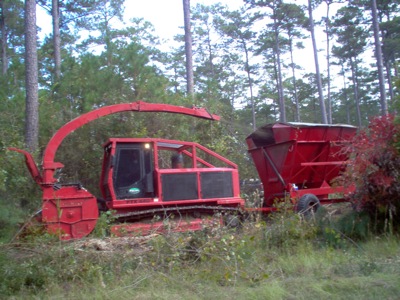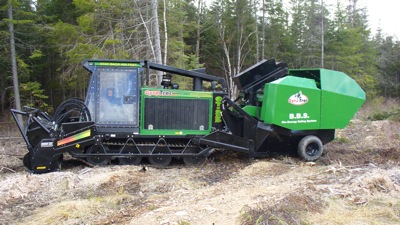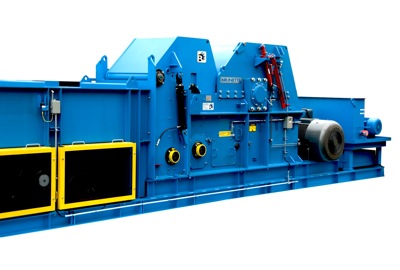
New technology at Biomass Conference
May 26, 2010
By Canadian Biomass
May 25, 2010, Minneapolis, MN – Canadian Biomass takes its gear coverage on the road, reporting on some of the new technology from the International Biomass Conference & Expo held in Minneapolis, Minnesota, in early May.
May 25, 2010, Minneapolis, MN – Canadian Biomass takes its gear coverage on the road, reporting on some
of the new technology from the International Biomass Conference &
Expo held in Minneapolis, Minnesota, in early May.
Mulching for biomass
 |
|
| Fecon's Bio-Harvester collects small woody biomass and helps provide a renewable biomass energy supply.
|
Gone are the days when mulch (now precious biomass) was left to rot on the ground on all land clearing, right-of-way, or line work. Both Fecon and GyroTrac were on hand to show off options to reclaim that valuable biomass. Fecon brought its Bio-Harvester, a machine that simultaneously fells, chips, and collects small-diameter woody biomass. The Bio-Harvester is ideal for pre-commercial and commercial thinning applications, non-merchantable timber, and brush. The Bio-Harvester helps provide a non-agricultural renewable biomass energy supply that enhances forest management practices. It harvests fire-prone ladder fuel material, producing wood chips from previously unused biomass sources. Wood chips can then be used to produce bioenergy via the generation of electricity or liquid fuel production.
www.fecon.com
 |
|
| GyroTrac's Bioenergy Baling System
|
Mulcher manufacturer GyroTrac has a prototype Bioenergy Baling System that can cost-effectively process, harvest, clean, compress, and bale all in one step, with one machine and one operator. There is no need for additional equipment such as tub grinders, crawler excavators, or large dump trucks. Production ranges from 18 to 44 bales/hour (4 x 4 foot bales), depending on tree size and terrain.
www.gyrotrac.com
BTI enters pellet machine business
Well known in the aggregates business for rugged machinery, Breaker Technology Inc. (BTI) has formed a Bioenergy Division offering a new concept in pelletizing. The Pellet Pro-4 is a new punch and die pelletizing technology that BTI says requires substantially less production energy, lower maintenance costs, and simple universal tooling suitable for processing a wide variety of raw materials into very dense pellets. The design features a variable rate output for energy conservation, no conditioning chambers or steam required, no additives or binders necessary, and easy operation. The quick change tooling allows mills to change the punch and die sets after normal wear and tear or to produce a different pellet diameter. Rated output from the Canadian-designed and -made machine is 1 to 4 tonnes/hour per unit, depending on the raw material.
www.rockbreaker.com
Briquetting hits North America?
It’s not all about pellets, or at least that was the message of several briquetting system suppliers on hand, including CF Nielsen, DI PIU, Hitech Agro, Biomass Briquette Systems, and RUF. Biomass Briquette Systems is a North American supplier that designs and engineers its equipment here and manufactures overseas for a combination of local industry knowledge and low-cost manufacturing. It offers a wide range of grinders, conveyors, silos, and briquette presses for turnkey systems of varying capacities. Complete systems or low-capital starter systems are available, with systems producing up to 8,000 tonnes/year coming in as low as $250,000. RUF U.S. was on hand to discuss the energy consumption advantages of producing briquettes over pellets. Whereas heating oil or liquid petroleum gas require 12% to almost 15% of their respective energy content for extraction, conversion, and delivery, and pellets require 2.7%, RUF claims that wood briquettes require just 1.3% of their energy value to manufacture.
www.biomassbriquettesystems.com
www.ruf-briquetter.com
{mospagebreak}
Biomass belt drier brings benefits
The Swiss Combi Belt Dryer uses the low temperature heat from other processes as a heat source for drying biomass, offering Canadian biomass players several advantages over high-temperature processes. For starters, there are no significant emissions of volatile organic compounds; thus, the lignins remain available as a natural binding product for pellets or briquettes. That also means no exhaust air treatment is required. The belt technique also reduces energy consumption, allows for an automated operation, provides high availability, and reduces maintenance costs over other options, according to the Swiss-based supplier.
www.swisscombi.ch
Whole log chipper for biomass
 |
|
| Brunette's Whole Log Chipper
|
Brunette has expanded its chipper line-up to include a Whole Log Chipper. This horizontal feed chipper has a powered upper press roll and powered lower bedroll to control the feed of the logs to give a high quality chip suitable for the biomass and pulp and paper industries. A hard surfaced anvil mounted in a break-away support frame prevents damage from foreign material. The knife to anvil clearance is easily checked through access doors mounted on each side of the chipper frame. The Brunette Whole Log Chipper includes a common sub-frame which ties the infeed, chipper, motor, and HPU together for rigidity, and one lift installation. It is available in various sizes and model configurations to suit specific needs.
www.brunetteindustries.com
Print this page